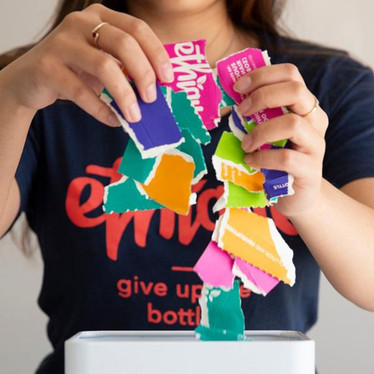
Compostable packaging: how does it work?
100% of our packaging and even our in-shower containers will decompose in your home compost heap. That’s a non-negotiable for us, and something we talk a lot about. You can safely say that yep, we love composting. But wait: isn’t all paper packaging compostable, we hear you ask? Not quite, and here are some common reasons why it’d have to go into landfill instead of back into the garden.
- It’s laminated or waxed.
Things like coffee cups (see above), most baking paper, and lots of food wrapping are coated with plastic or petroleum-based wax.
- It has sneaky plastic.
Lots of paper-based products have tiny bits of plastic that won’t break down. Those shiny cardboard boxes that top-shelf moisturiser, give that box a tear and you’ll see a very thin film of plastic.
- It has inks, acid or chlorine that will be toxic when the item breaks down.
Our cardboard boxes – and everything we send through the mail – are free from acid, chlorine, laminates and plastic, so they are completely compostable. We use vegetable inks too, which worm farms can cope with. Essentially, you shouldn’t have to throw anything you get from us into landfill. It can all go in the garden.

Identifying compostable packaging
Generally speaking, if the packaging looks and feels like paper and has a ‘home compostable’ label somewhere on it, it’s probably good to go.
Be mindful – a seemingly 'compostable' piece of material may not be suitable for your home compost. There's a big difference between home compostable vs commercial compostable, and more often than not compostable packaging is fit for commercial composting only. Most cardboard or paper that’s waxed or coated can’t be recycled or composted and will need to go to landfill. Anything that’s highly coloured and doesn’t mention anything about compostability should probably just go in the recycling – you don’t know what those inks are going to do out there in the wild. Ours is brightly coloured, true, but we’ve made sure the ink is safe for compost heaps and we’ve tested it on our own worms, too (newsflash: they love it).
Why should we compost?
Perhaps the question is ‘why isn’t everyone composting?!’
- Composting will break down what landfill can’t
We all know landfill isn't ideal - it takes up space, produces methane and other toxic gases. Composting allows us to reduce the quantity of waste we send to landfill and cuts greenhouse gas emissions. Better for your health, and better for our planet.
- Compost makes new soil
Guys, we’re running out of good dirt. With deforestation, intensive farming and development, we’re swiftly losing our top soil – you know, the stuff we need to grow food. Some places suggest that we’re losing soil at between 10 and 40 times the rate it’s being replenished. Composting, turns waste into nutrition, breathing life into stripped soils, and ultimately letting us grow more food.
- Composts don’t smell
We promise – a healthy compost heap will smell earthy – not that rotten-eggs smell you’d usually associate with rotting food. If it starts to smell it means something’s not right. Follow our tips below to keep your compost healthy, smelling earthy and fresh.
- Your garden and its residents will thrive
Compost creates a healthy environment creepy crawlies will love - and your garden will feel (and look) better for it. We all know these bugs might not be our best friends, but they're critical for a functioning ecosystem and our survival. They make our soil we need to grow food, and break down errr...waste products. Better yet, keep them happy in your garden where they can thrive, and the less likely they are to show up in your house!
- It’s easy and costs next to nothing
All you need is some garden space (or your kitchen benchtop or windowsill will do). If you want to contribute your compost but still aren’t ready to start your own, try reaching out to your composting neighbours. They’re likely to appreciate your extra food waste to add to their own. Read on for our compositing at home beginner tips.
Okay, so... how can I start composting?
Honestly, it’s not that hard. While there are composting enthusiasts who make a real science of it, generally you just pile organic things up and let them rot down. The best kind of heap will have a good mix of stuff in it: juicy, dry and light, and woody stuff, all layered like a big, delicious, rotting parfait.
Woody bits of stick, bark and cardboard create a structure in the heap that lets air circulate – think about this as your compost heap’s flue. Light leafy things, like grass clippings, will decompose really fast, creating lots of heat, which keeps your heap working hard – this is like your kindling. That means the heap is all ready to take on the heavy duty work of breaking down the nutrition in banana peels, onion skins and celery ends. And to super-charge your compost? Poo. Avoid faeces from animals that eat meat (like cats and dogs) because it can introduce dangerous bacteria to your spring lettuces. But horse and cow dung, or the scrapings from your guinea pig cage or chicken coop – that’s all good stuff.
If you’re not in a hurry, just chuck everything in as is – mother nature will deal to it, if you give her enough time. If you’d like to use your compost sooner rather than later, it’s a good idea to help along anything that takes longer to compost. Crush egg shells, chop up banana skins and avo peels and pits into smaller pieces, and rip compostable cardboard and paper into finger-sized bits.
And then you can just leave it, or to be a compost A-student, turn your heap every couple of weeks with a garden fork. It’s heavy work, but it speeds everything up by getting new waste into the hot centre, and letting the air circulate nicely.
Happy composting!
Discover our eco-friendly Mindful Brands like Ethique, and support meaningful change.

